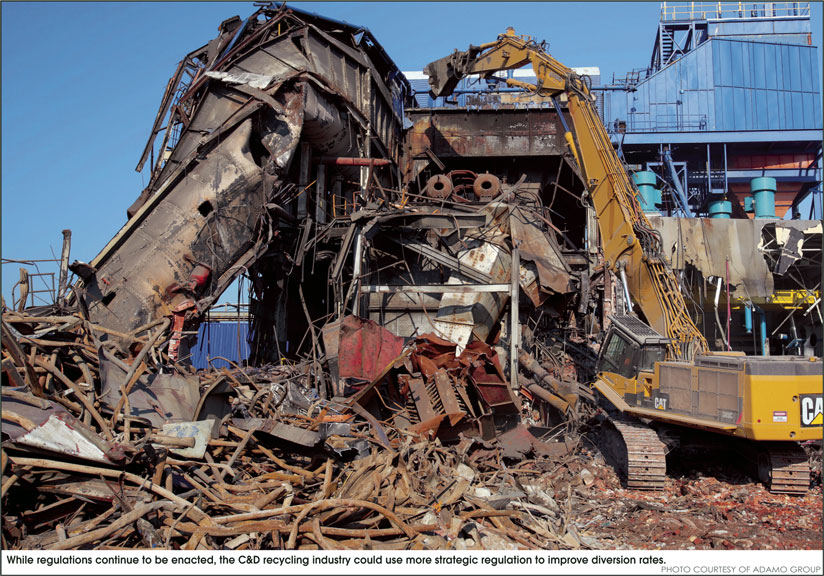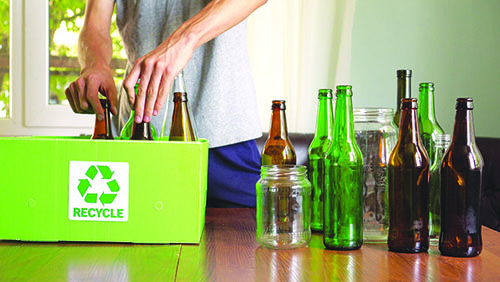by MAURA KELLER
From silica dust violations to regulatory statutes surrounding environmental and public health stressors at recycling facilities, the construction and demolition (C&D) recycling industry is facing a myriad of new state regulations that companies should be aware of.

Adam Richards, a board certified construction attorney at Berger Singerman in Miami, Florida pointed out that state regulations seem to be in flux regarding the construction and demolition materials.
“Certain states are more proactive, especially those leading the charge with respect to renewable energy. In addition, several states have established minimal percentages for C&D recycling either per project or per capita, but regulatory hurdles still exist because even in some of those states with set minimums, the metric is merely a goal as opposed to a requirement,” Richards said. “Regulating C&D recycling is a good first step, but significant work remains to not only create an environment where recycled materials are sought and utilized, but where C&D recycling is accounted for and maximized project by project.”
Sara Kingman, a senior sustainability engineer with Buro Happold in Los Angeles, has extensive experience with waste management building concepts for zero waste, as well as building-level and masterplan sustainability concepts and the administration of roughly a dozen LEED projects.
As Kingman explained, while regulations continue to be enacted, the C&D recycling industry could use more strategic regulation to improve diversion rates.
“When done correctly, increased regulation has proven to be highly effective,” Kingman said. An example is the City of San Jose’s Construction & Demolition Diversion (CDD) program, which financially incentivizes projects to recover materials from C&D activities. According to the City of San Jose, more than 30 percent of landfill waste is construction and demolition debris. The CDD program ensures that at least 75 percent of this waste is recovered and diverted from landfills. The CDD program uses financial incentives to encourage the recycling of C&D material and requires projects to achieve a 75 percent recycling rate. Homeowners, contractors or developers pay a deposit when they apply for a construction permit with the City of San Jose. The deposit is fully refundable if the C&D materials were reused, donated or sent to a certified processing facility.
“Additionally, CalGreen requires a high percentage of recycling of construction materials, and LEED has proven effective at raising the bar for construction material diversion as well,” Kingman said. “But there is minimal focus on demolition waste, which comprises roughly 90 percent of all C&D waste.”
Currently a hazardous waste “treated wood waste” bill (SB 557) is being proposed in California. This bill would define the term “treated wood” and would require treated wood waste, as defined, “to be disposed of in either a class I hazardous waste landfill or in a composite-lined portion of a solid waste landfill unit that meets specified requirements.” The bill would require any solid waste landfill accepting treated wood waste to meet certain requirements specified in the bill and to manage the treated wood waste in a specified manner. The bill would authorize treated wood waste to be reused only if certain conditions apply, including, among other conditions, that the reuse occurs on-site at the facility at which the treated wood waste was generated.
While California leads the charge with recycling laws enacted to offset the impact of C&D waste, other states have also initiated regulations surrounding the proper disposal of C&D materials. Recently, New Jersey’s environmental justice bill (S-232) signed by Gov. Phil Murphy garnered much attention among the C&D recycling community. The bill allows the New Jersey’s Department of Environment Protection (NJDEP) to “evaluate the environmental and public health stressors certain facilities may pose on overburdened communities when reviewing certain permit applications.” These facilities can include solid waste facilities, recycling facilities, scrap metal facilities, landfills, medical waste incinerators and transfer stations.
The bill allows the NJDEP to deny permits to entities if they find a significant level of impact on an overburdened community.
In July 2020, the Institute of Scrap Recycling Industries (ISRI) submitted a written testimony to the New Jersey Assembly Environment and Solid Waste Committee in opposition to the New Jersey environment justice bill.
Jarred Dorfman, president of ISRI’s New Jersey Chapter, indicated support of the concept of responsible environmental justice legislation, but noted ISRI is concerned that, “without amendments, S-232 will harm New Jersey and its recycling goals by imposing onerous restrictions and costs on recycling facilities that need to renew their NJDEP permits or are looking to invest in new, environmentally-friendly equipment, expand operations, or even develop new facilities that incorporate state-of-the-art technology, including for pollution abatement.”
Dorfman went on to say, “the legislation specifically calls out recycling and scrap metal facilities while not citing other common industrial and commercial operations. Most importantly, by targeting recycling while at the same time promoting the growth of recycling through simultaneous efforts in the New Jersey legislature, such as with S-2515, the legislature is creating an impossible situation for the recycling industry in the state.”
From New Jersey to Oregon to California, C&D recycling regulations that are emerging continue to keep recycling companies on their toes. And while it can be challenging to keep up with all the changes in so many state jurisdictions, the Northeast Recycling Council created a helpful list of all statewide disposal bans and mandatory recycling guidelines in the country. The list is regularly updated, most recently in October 2020.
“Interestingly it is often the municipalities that impose additional requirements. Seattle’s Salvage Assessment requirement and San Jose’s CDD recycling incentive program, come to mind,” Kingman said. “As does New York City’s source-separation requirement.”
As part of its salvage assessment program, Seattle requires that construction and demolition permit applicants complete a Salvage Assessment for whole building demolition projects and projects that involve alterations valued at more than $75,000 and/or where the area of work is greater than 750 sq.ft.
Biggest Concerns
Some leading C&D waste issues pertinent for both waste and recycling companies as well as governmental entities include dissimilar regulations by jurisdiction, high contamination rates, wasteful use of raw materials, landfill emissions generated due to improper processing at the end of the material lifecycle, unnecessary reliance on byproducts of coal production, the lack of any infrastructure or regulations to support reusing salvaged construction materials, and the large amount of carbon associated with the extraction, transport, and processing of raw materials.
The types of materials being used or disposed within the C&D environment is also impacting the recycling industry. “The primary material of concern is gypsum,” Kingman said. “When landfilled, wallboard breaks down anaerobically and produces hydrogen sulfide, which is toxic, corrosive and even flammable. Over the past decade, states have increasingly banned the landfilling of wallboard. Building Product Ecosystems, founded by Amanda Kaminsky, is a good example of a company striving to close this loop. Gypsum can be recycled indefinitely into new wallboard, so Building Product Ecosystems is focusing on source separation, processing, and remanufacturing of scrap gypsum.”
Kingman pointed to 2018 EPA data that indicates that a majority of concrete waste nationwide is reused as aggregate. Likewise, a majority of asphalt pavement and metal waste is reused in manufactured products.
“However, these positive signs are mitigated by the fact that the majority of wood, gypsum drywall, asphalt shingles and brick and clay tile waste continues to go to landfill,” Kingman said. “There are regulations that could positively impact individual municipalities, but at the national level there is still a lot of room for improvement in construction and demolition waste diversion rates.”
A Growing Industry
Increasing regulations aside, according to Richards, the recycling of C&D materials has created hundreds of thousands of jobs nationally, and is viewed favorably by environmentalists due to the conservation of landfill space, the reduction in disposal facilities, the extraction and consumption of virgin resources and production of new materials.
“The regulations have further bolstered the industry by reducing transportation costs, and incentivizing charitable donations as well as the avoidance of certain purchase/disposal costs,” Richards said. “And these regulations are helping the industry grow, albeit slowly. For example, only a handful of recyclers exist in the South Florida market despite development booming over the last decade and not slowing down throughout the area.”
Because LEED, CalGreen and other standards only focus on construction waste, Kingman said the industry is only looking at the tip of the iceberg.
“Thankfully, the circularity movement has begun to shift focus to demolition waste. For example, several carpet manufacturers such as Mohawk Group and Interface have implemented material takeback programs at end-of-life,” Kingman said. “This needs to become more widespread.”
At the same time, Kingman stated that designers, architects and engineers must design to allow for deconstruction, rather than demolition.
“Likewise, government regulation can aid the transition by requiring certain products to be separated prior to deconstruction. This would encourage more manufacturers to create takeback programs, as separation results in less contamination, thereby allowing the material to be reused in the manufacturing process,” Kingman said. “The market will further drive manufacturers to implement takeback programs, as reusing materials will reduce their costs.”
Another piece of regulation that would facilitate C&D waste reduction would be increasing the cost to landfill materials.
“This would drive contractors to pursue alternative options, which would drive the market to develop those options, whether recycling facilities, storage facilities for salvaged materials, etc.,” Kingman said.
Under a progressive administration, it is possible that the Environmental Protection Agency could advance C&D recycling regulations at the federal level, imposing minimum standards for all U.S. jurisdictions.
“Regardless of regulation, there are other drivers of needed change that leaders in the recycling industry can recognize, encourage and support,” Kingman said. “This includes increased stringency around C&D recycling under sustainability frameworks such as LEED; accelerating public awareness of – and thus market demand for – waste reduction; and cost-savings opportunities associated with reducing waste, carbon, and raw material extraction.”
Richards said that C&D recycling regulations will continue to evolve in the future by adjusting certain metrics (i.e., percentage of C&D debris that must be diverted from a project, whether public or private), responding to cost and environmental considerations, and perhaps gaining more traction and popularity, given the rising material costs currently plaguing the construction industry throughout the country.
“Recycling companies must pay attention to the ever-changing landscape in their particular state,” Richard said. “This includes requirements as opposed to goals. They should seek to collaborate with city or state officials, as well as developers and contractors towards maximizing C&D recycling for any particular project.”
Published in the July 2021 Edition







